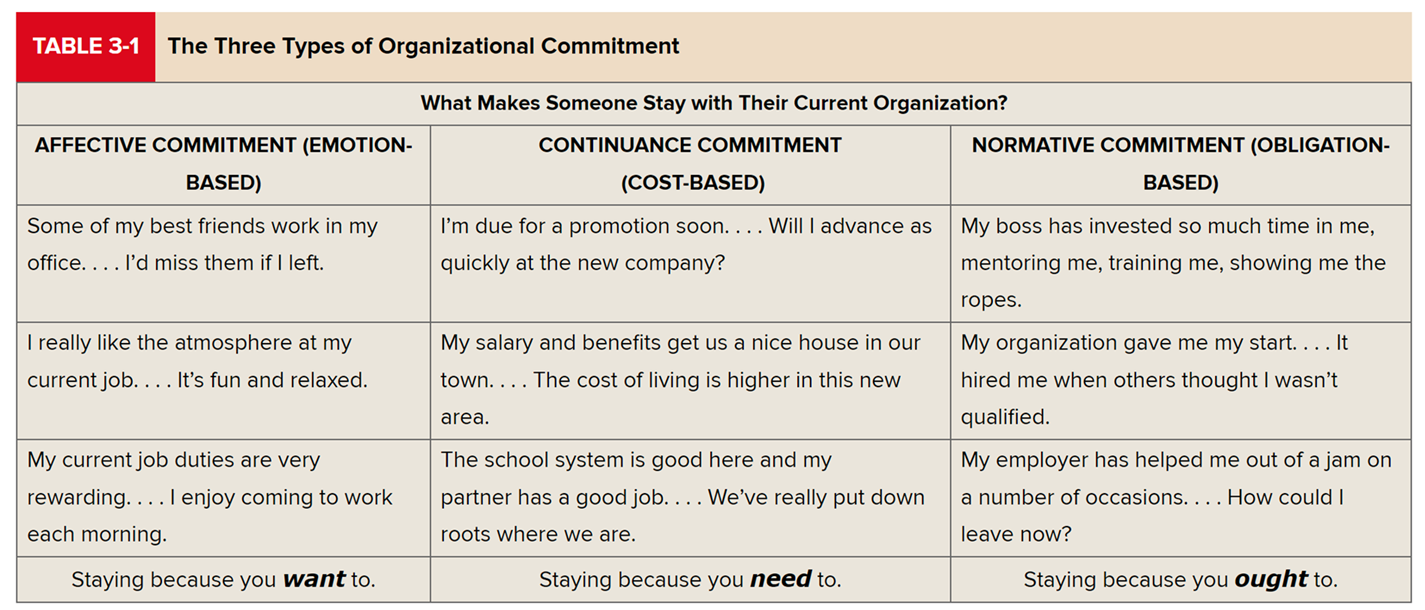Module 2 - Organizational Commitment (Auburn BUSI-7140 Exam 1)
1/24
There's no tags or description
Looks like no tags are added yet.
Name | Mastery | Learn | Test | Matching | Spaced |
|---|
No study sessions yet.
25 Terms
****What is Organizational Commitment****
An employee’s desire to remain a member of an organization
What are the 3 type of Organizational Commitment?
Affective commitment
Continuance Commitment
Normative Commitment

What is the Focus of Commitment?
The people, places, and things that can inspire a desire to remain a member of an organization
What is Affective Commitment?
An employee’s desire to remain a member of an organization due to a feeling of emotional attachment
Consider the Erosion Model and the Social Influence Model
What is the Erosion Model?
A model that suggests employees who have fewer bonds with coworkers are more likely to quit organizations than employees who have more bonds with coworkers
What is the Social Influence Model?
A model that suggests employees who have direct linkages to coworkers who leave the organization will themselves become more likely to leave
What is a practical application to increase Affective Commitment?
Increase the bonds that link employees together
What is Continuance Commitment?
An employee’s desire to remain a member of an organization due to an awareness of the costs of leaving
Consider Embeddedness
What is Embeddedness?
An employee’s connection to and sense of fit in the organization and community
What is a practical application to increase Continuance Commitment?
Create personal and professional costs of leaving through compensation packages and job crafting opportunities
What is Normative Commitment?
An employee’s desire to remain a member of an organization due to a feeling of obligation
Consider Perceived Organizational Support
What is Perceived Organizational Support?
The degree to which employees believe that their organizations value their contributions and care about their well-being
What are practical applications to increase Normative Commitment?
Provide training and development opportunities
Mentor followers and junior coworkers
Create shared experiences
What is Withdrawal Behavior? What are the two types?
Employee actions that are intended to avoid work situations
Psychological Withdrawal
Mentally escaping the work environment
Physical Withdrawal
Removing your body from the work environment

What are the 3 Models of Withdrawal?
Independant Forms Model
Compensatory Forms Model
Progression Model
What is the Independent Forms Model of Withdrawal?
A model that predicts engaging in one type of withdrawal has little bearing on whether employees engage in other types of withdrawal
What is the Compensatory Forms Model of Withdrawal?
A model that predicts engaging in one type of withdrawal makes employees less likely to engage in other types of withdrawal
What is the Progression Model of Withdrawal?
A model that predicts engaging in one type of withdrawal makes employees more likely to engage in other types of withdrawal
What are practical applications to the forms of withdrawal?
Loyalty has decreased over time for employees and organizations. This reality presents a challenge for leaders as they help followers be committed and happy.
Malicious Compliance
What are Psychological Contracts?
Employees’ beliefs about what employees owe organizations and what organizations owe them
Transactional and relational
What are practical applications to increase Organizational Commitment?
Create an organizational culture that builds affective commitment by helping employees establish connections with each other and the organization
Help followers understand the costs of leaving
“Grass is always greener” effect
“Bad is always stronger than good” effect
Help followers appreciate the various ways others in their organizations have tried to support them so they build normative commitment
What is Organizational Culture?
The shared social knowledge within an organization regarding the rules, norms, and values that shape the attitudes and behaviors of its employees
Observable artifacts
Espoused values
Basic underlying assumptions
What are Observable Artifacts?
Aspects of an organization’s culture that employees and outsiders can easily see or talk about
What are Espoused Values?
The beliefs, philosophies, and norms that an organization explicitly states
What are Basic Underlying Assumptions?
Employees’ ingrained beliefs and philosophies